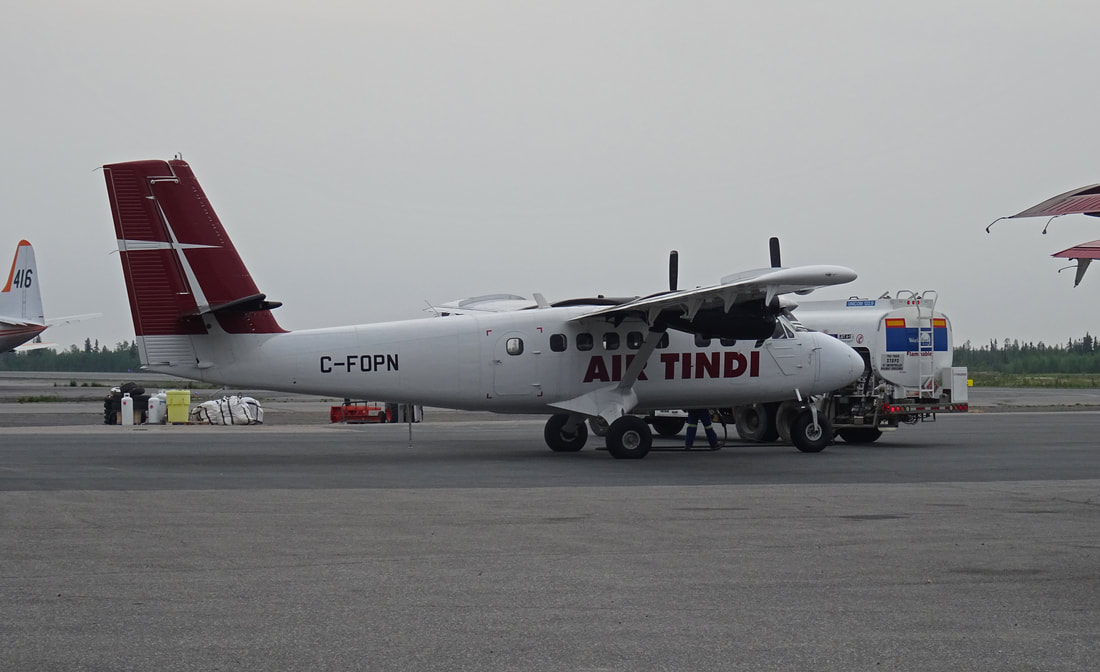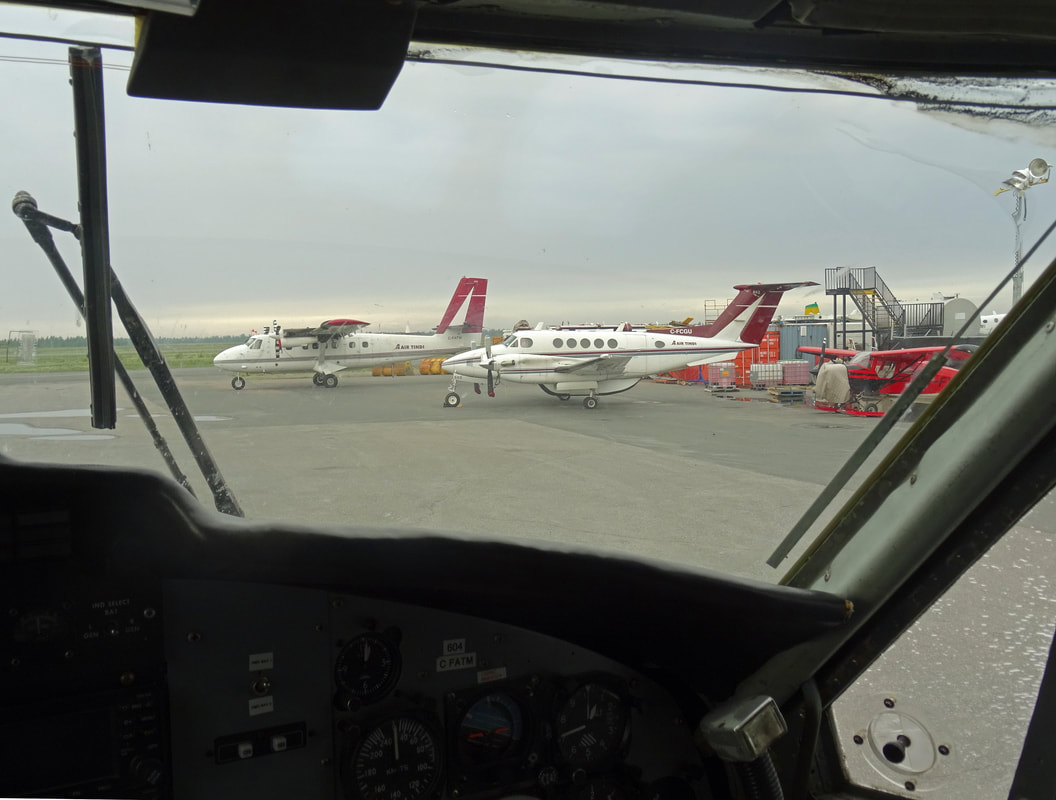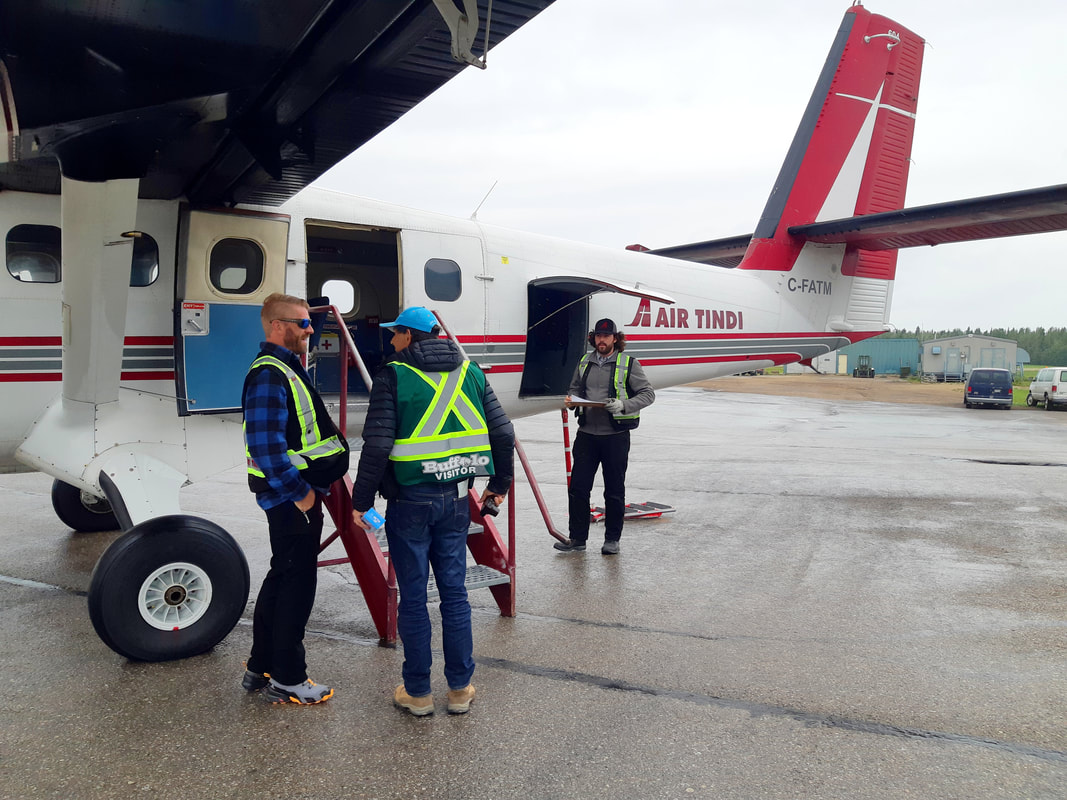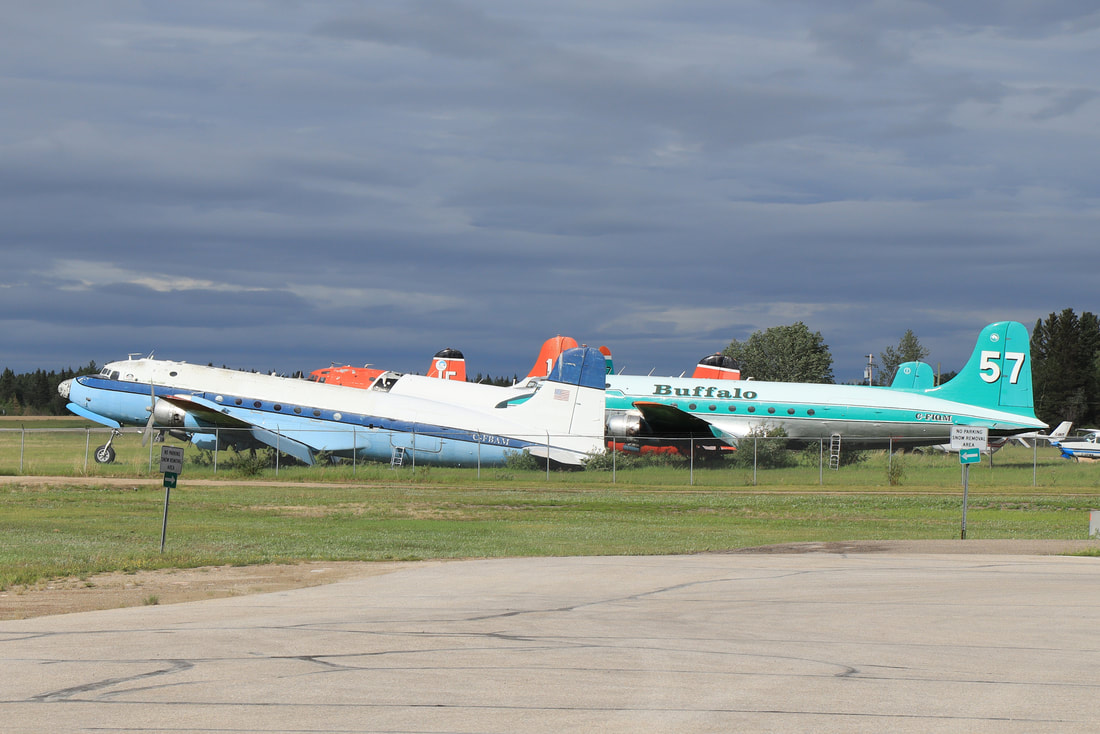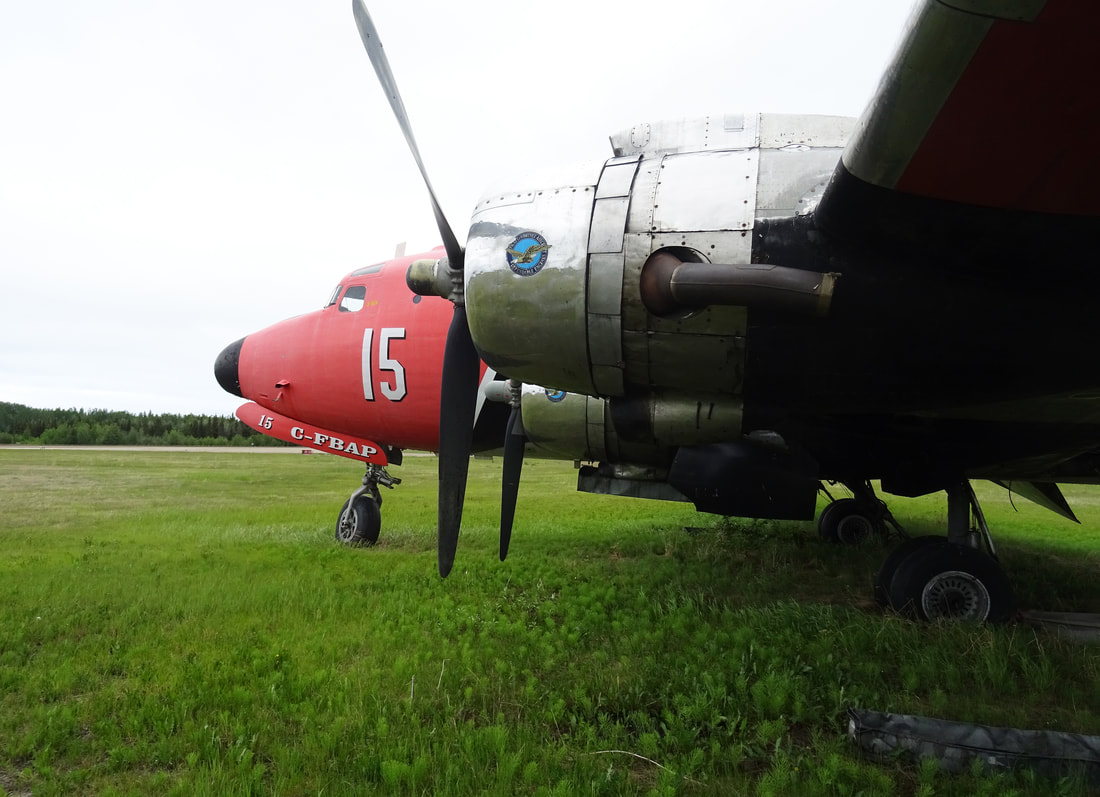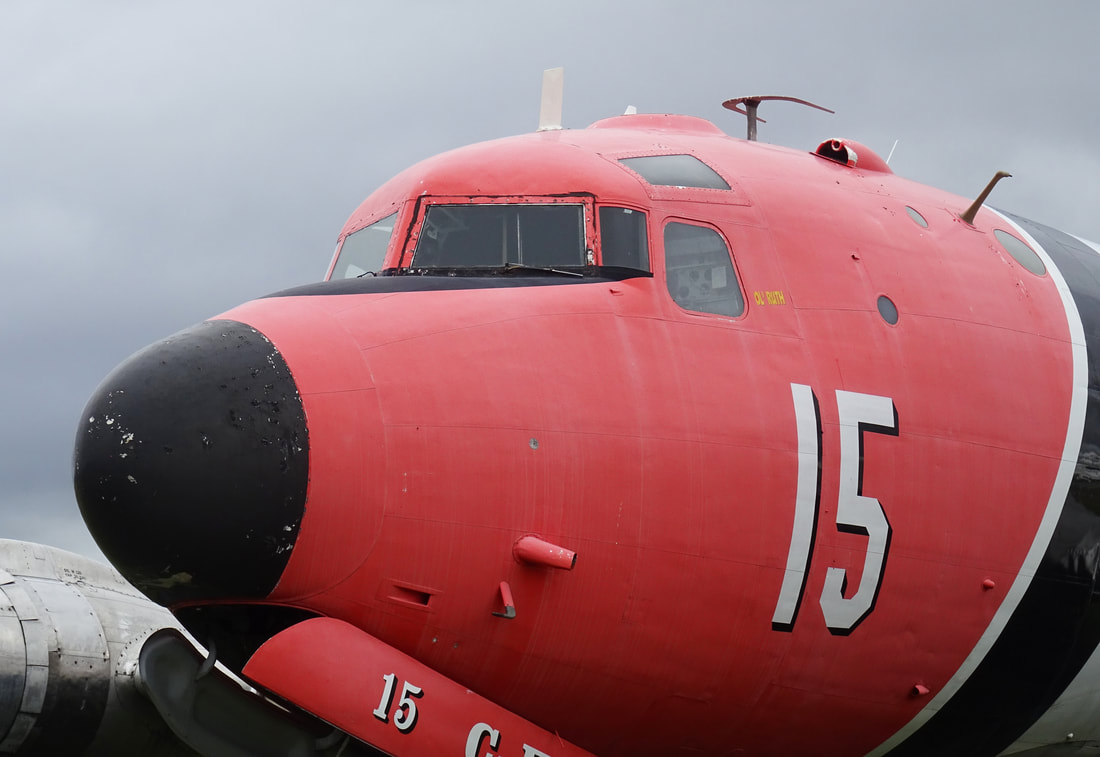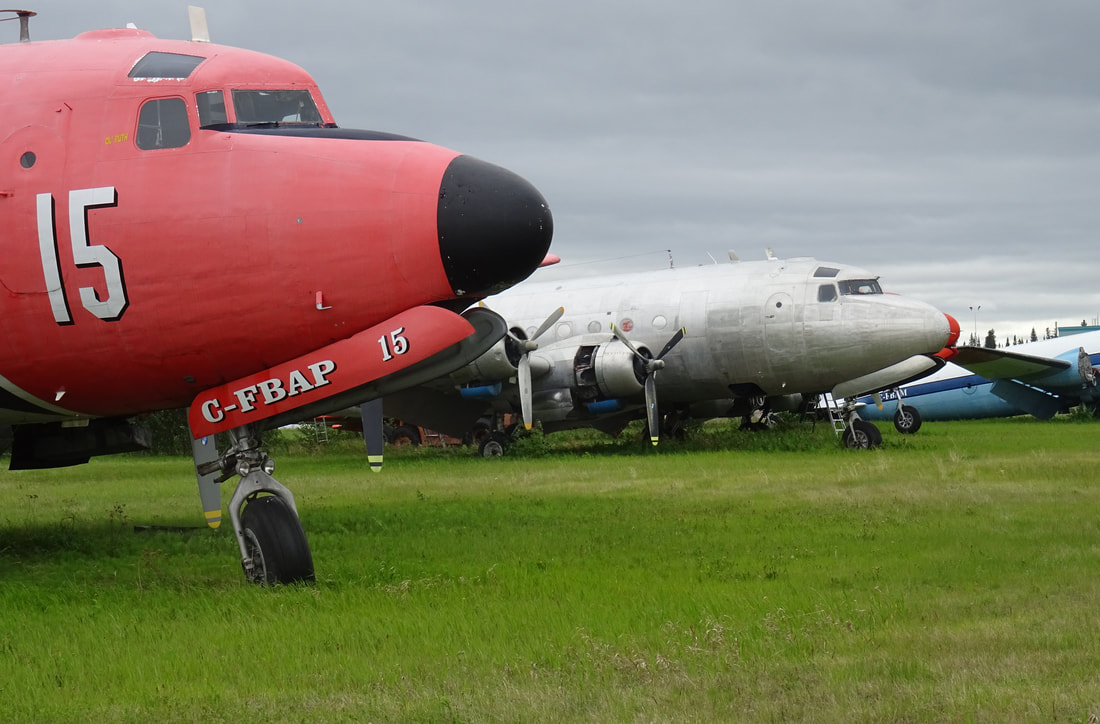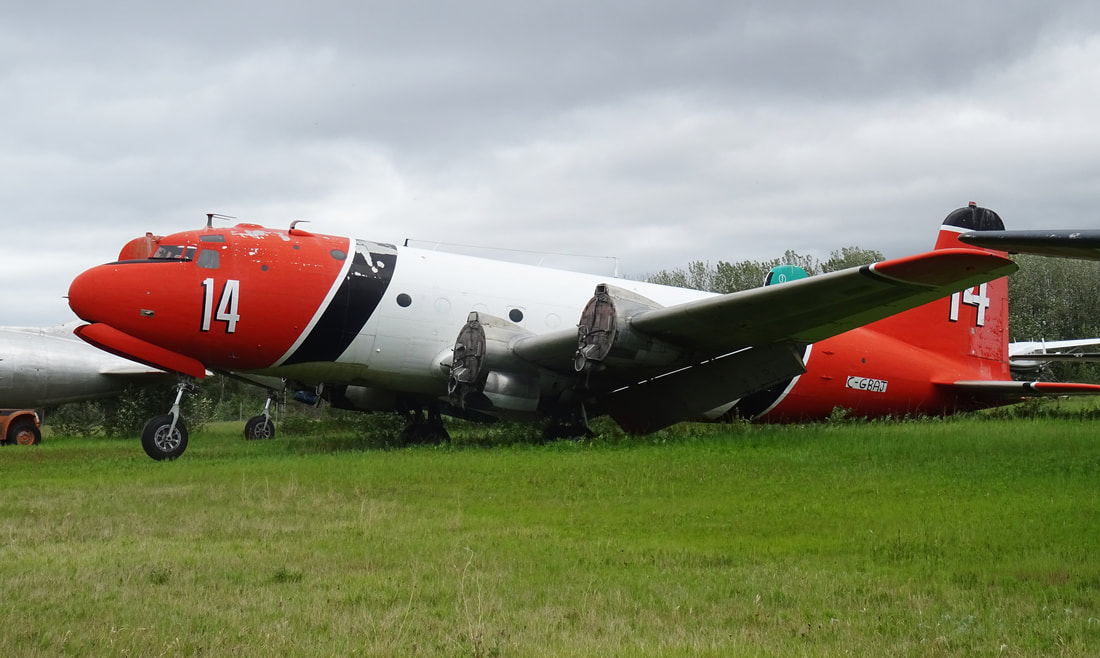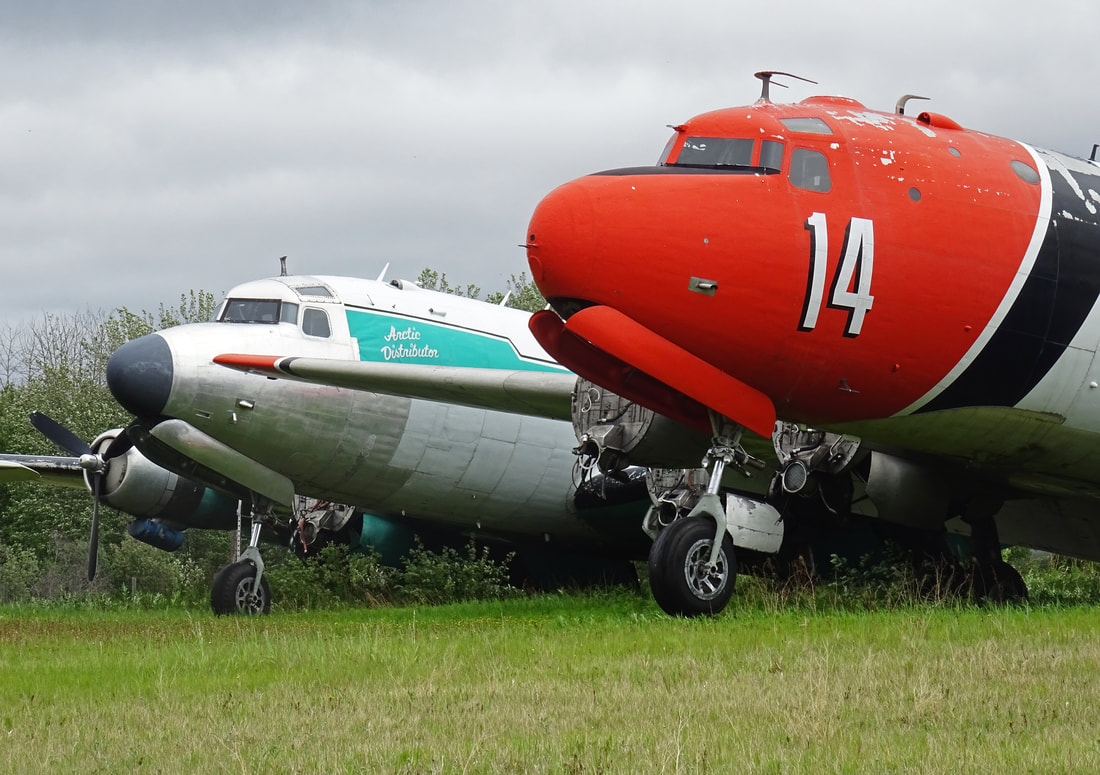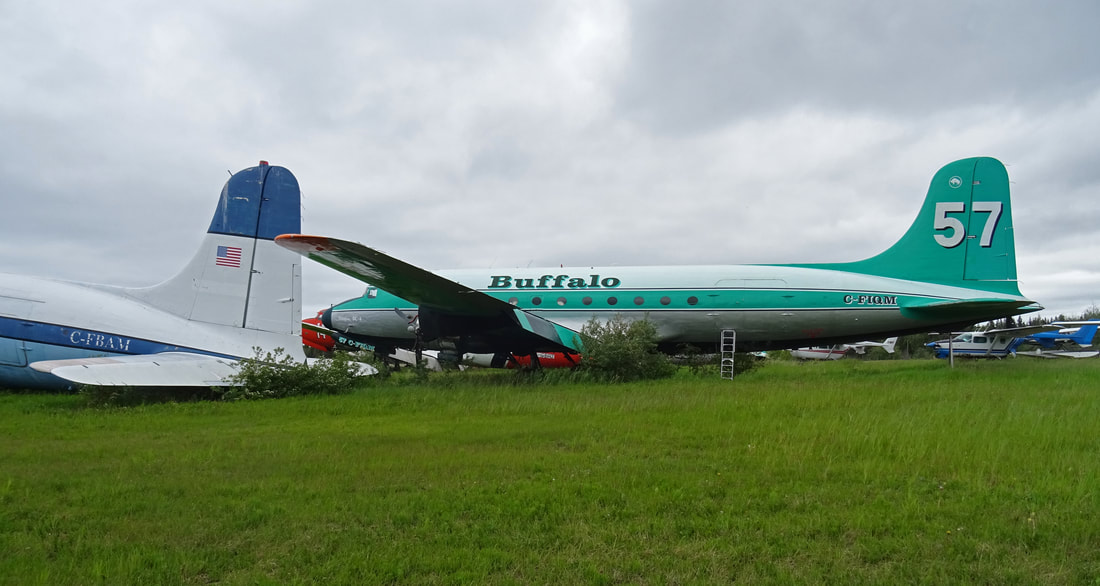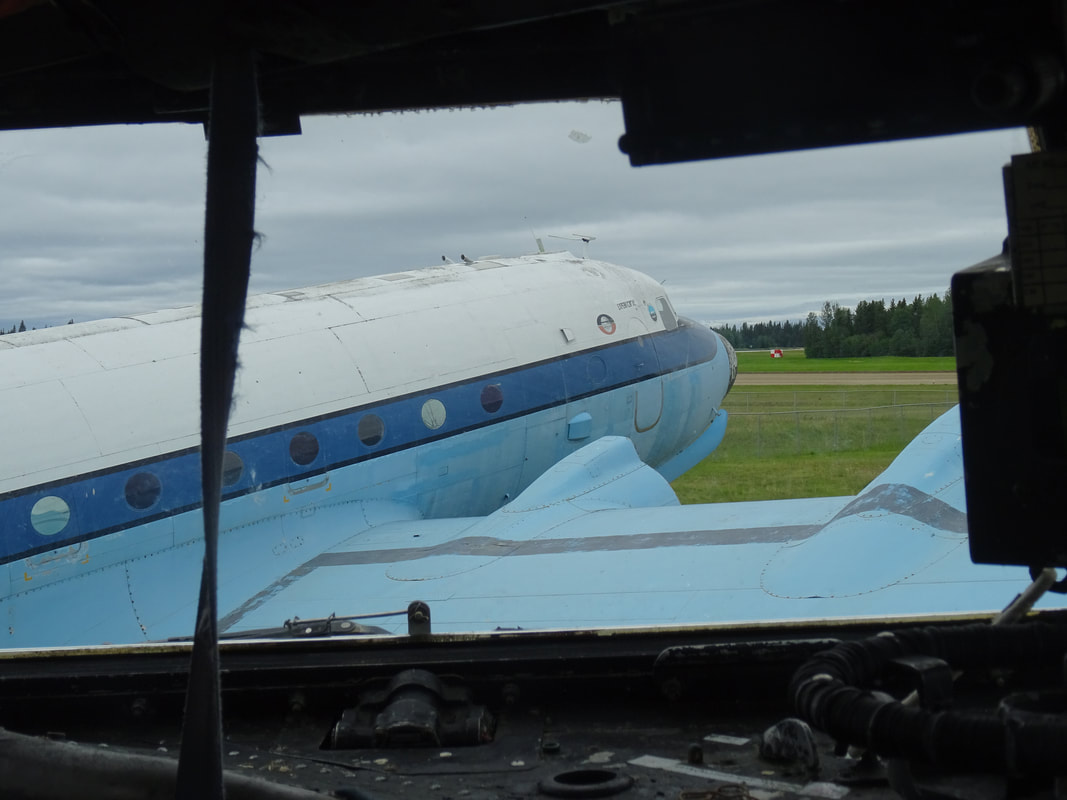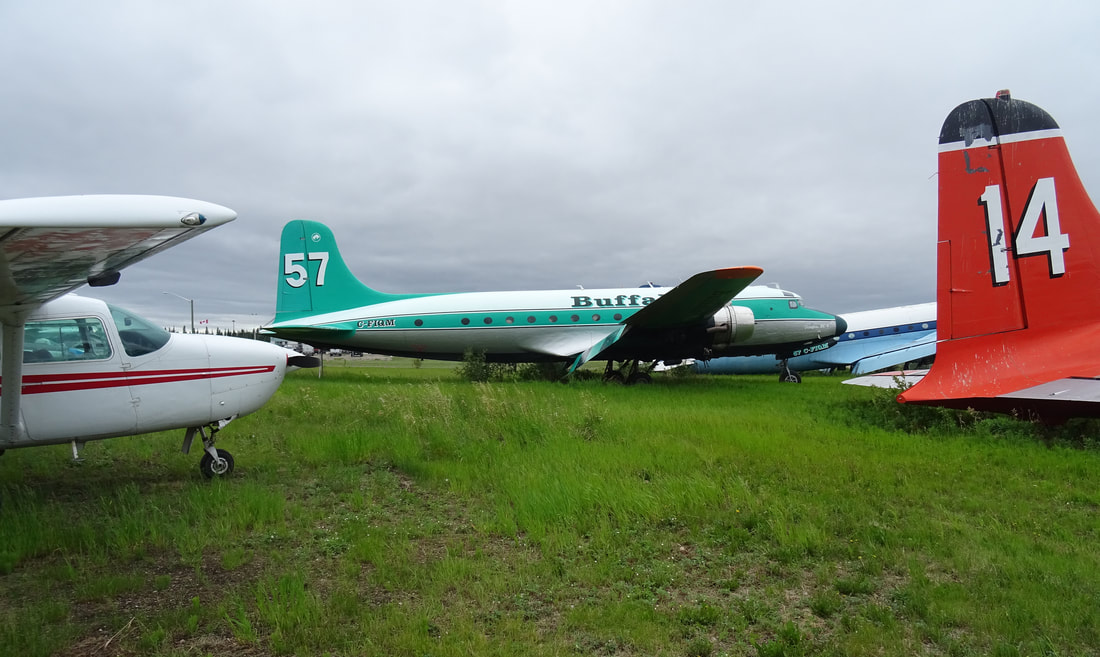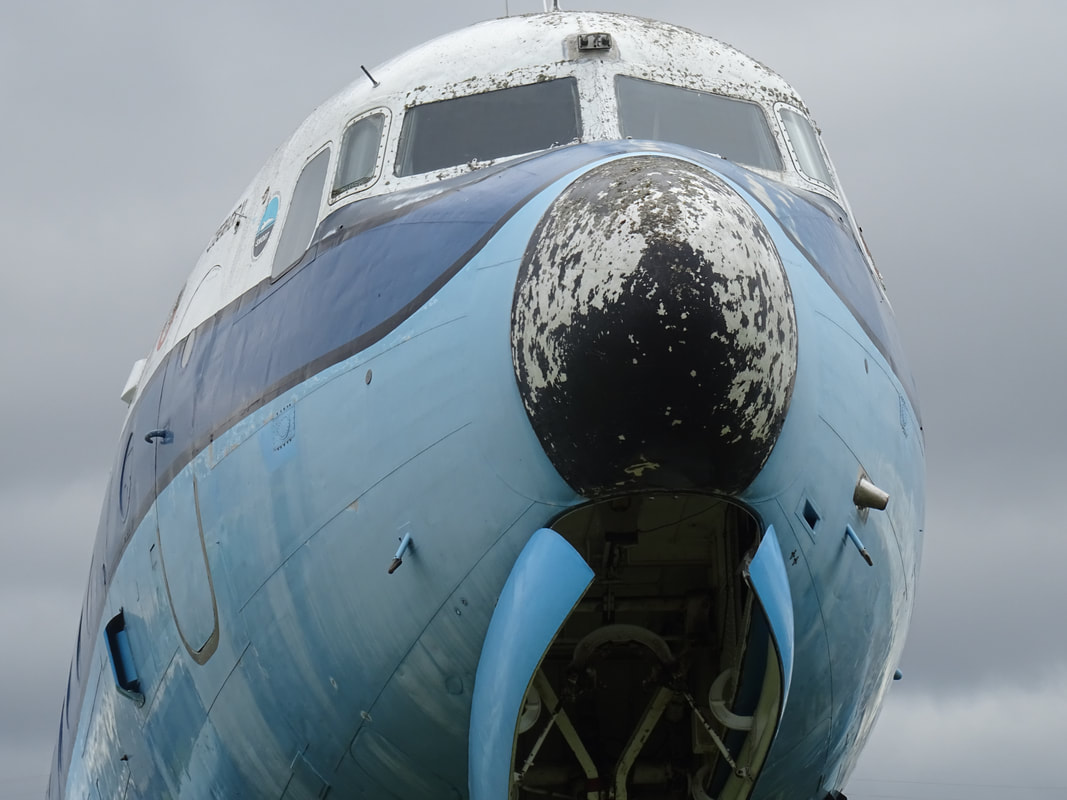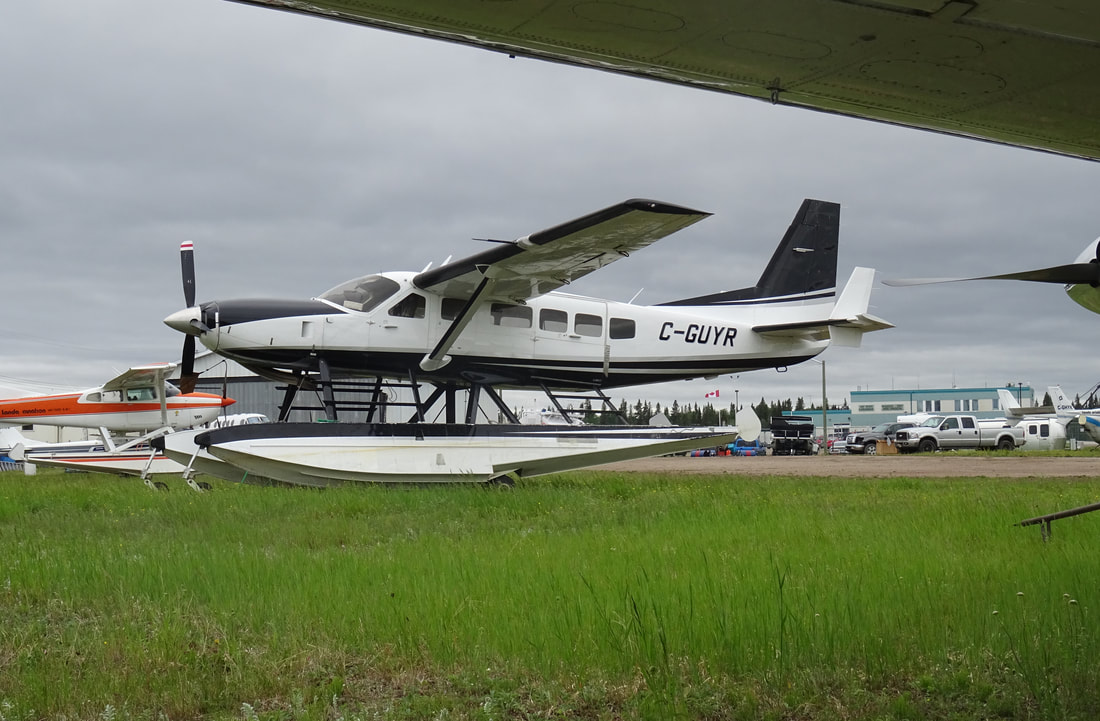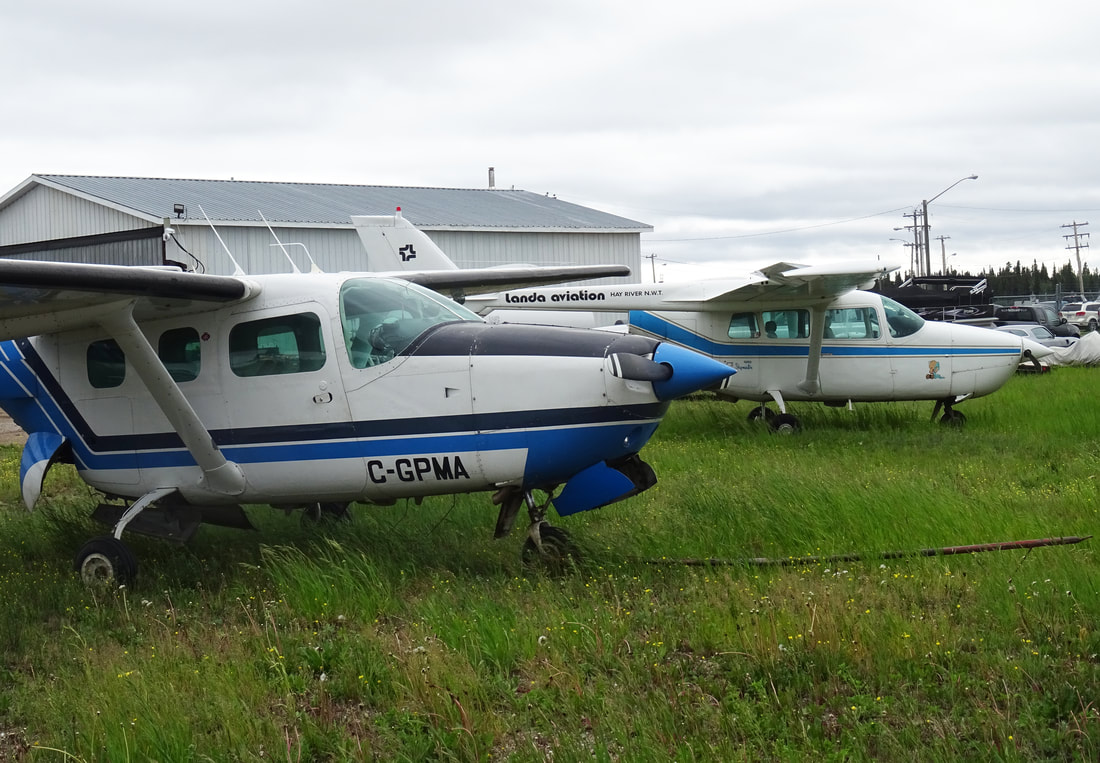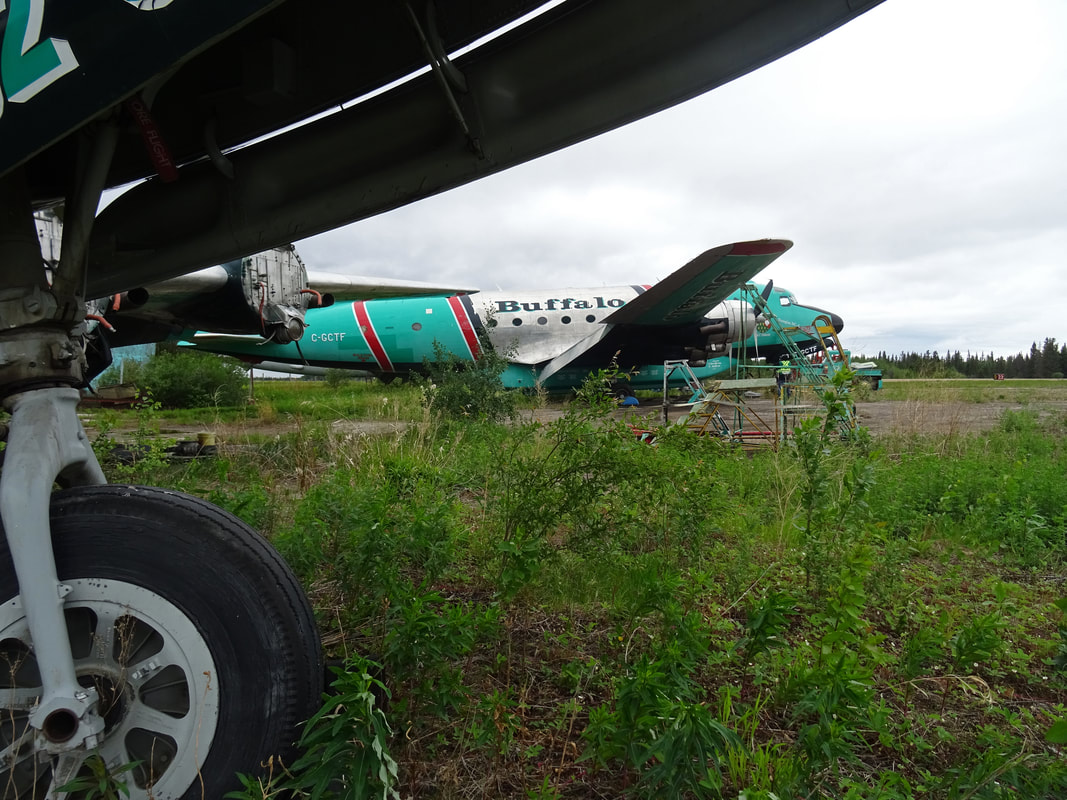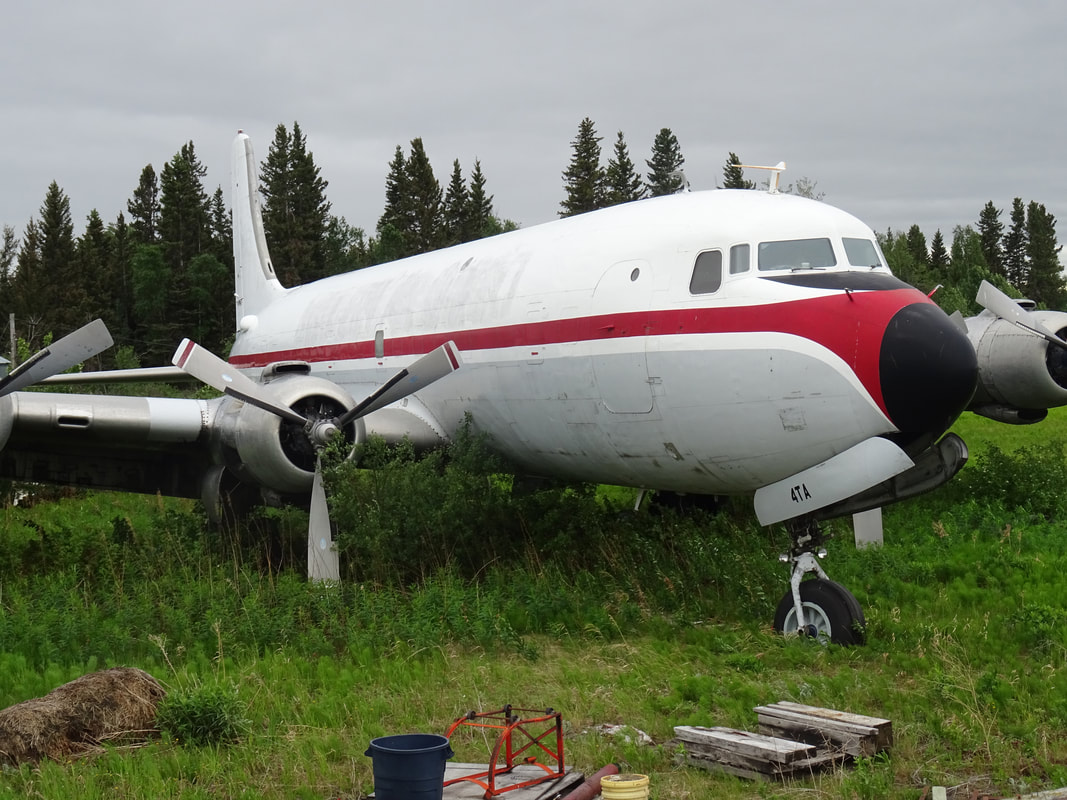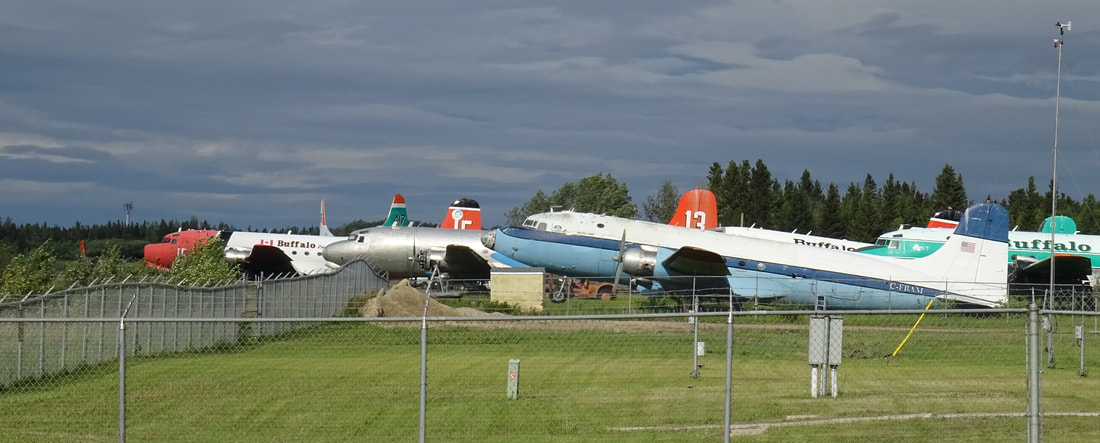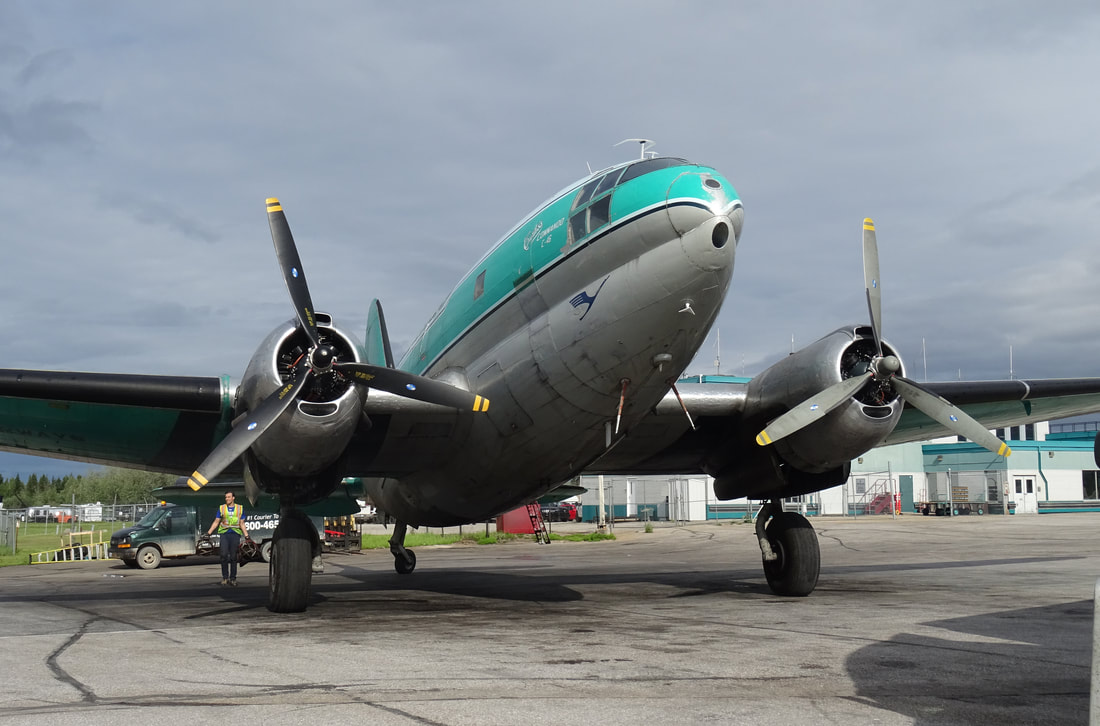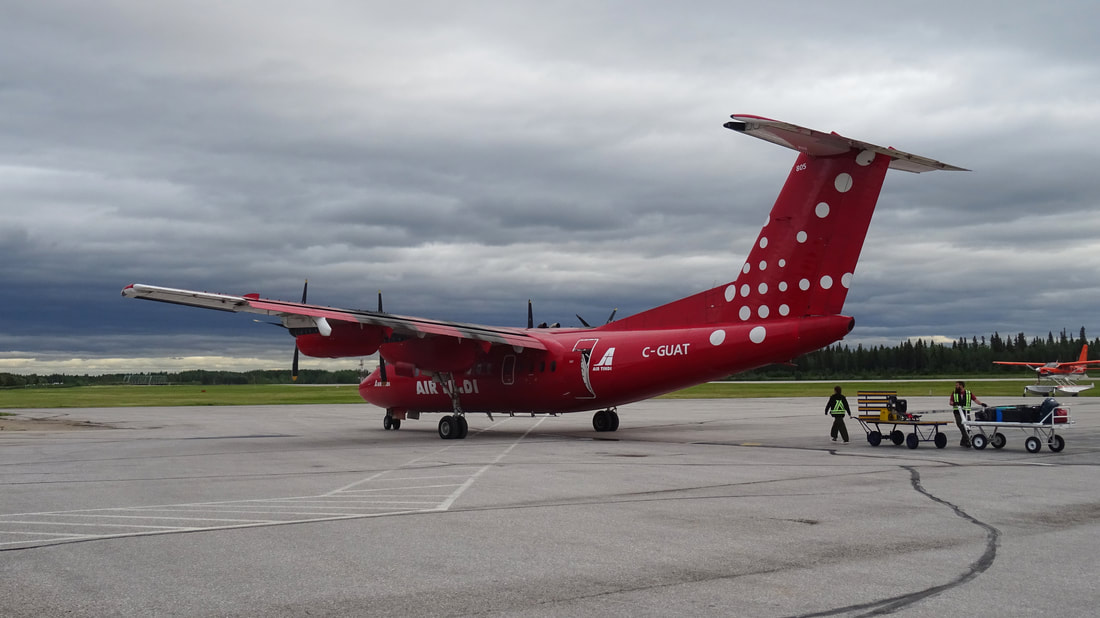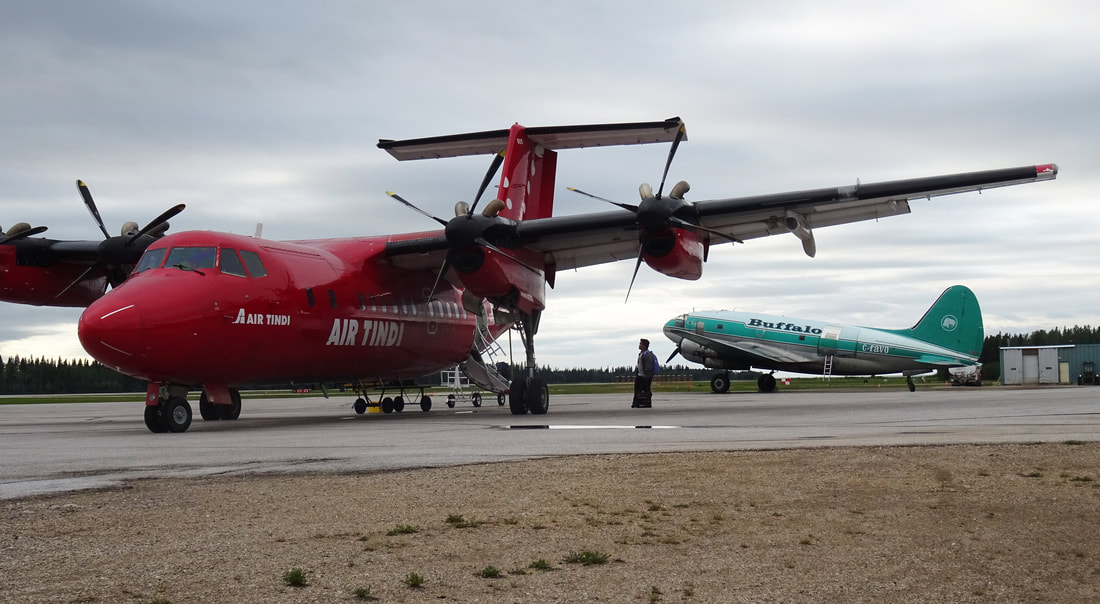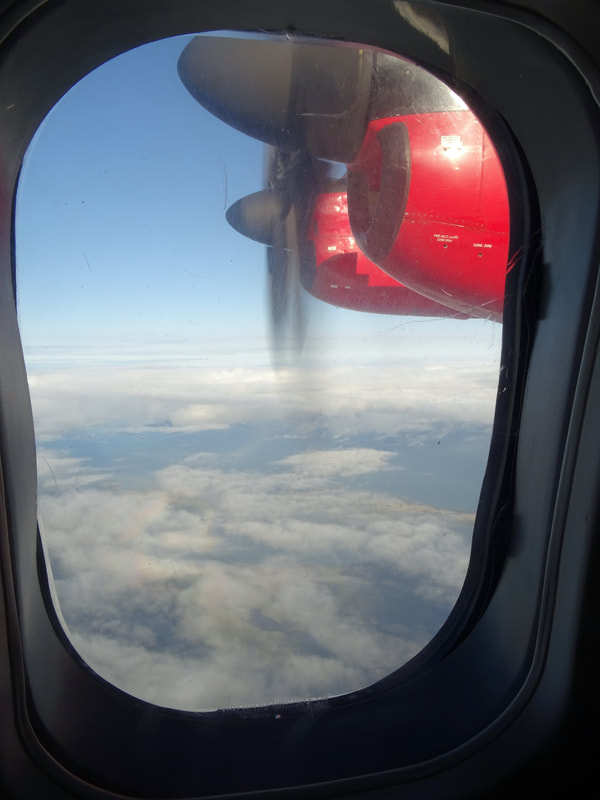Hay River
June 2023
Our flight 8T/240, was departing in the early morning from YZF, for a short 45 minutes flight, to Hay River on June 08, 2023.
C-FATM a 1969 built DHC-6-300 Twin Otter at Yellowknife, with sistership C-FOPN. 'ATM' is ex Trans Australia VH-TGE. Later Marathon Oil Company Pakistan as AP-AXP and then a whole bunch of odds & ends. After that she became part of the Air Tindi fleet in February 1998.
This 1970 built Twin Otter was delivered new to PIA - Pakistan International Airlines. During her long career, this veteran workhorse, was once withdrawn from use at Brazzaville, Congo and was in derelict condition by 1995. Fortunately, via sea container and road transport she found her way back to Canada for a complete rebuild with was finalized in 2010. In May 2021 Air Tindi became the owner.
This airframe crashed on Tau Island, American Samoa, January 05, 1970, while on delivery flight to Trans Australia Airlines. The wreckage was shipped to Australia and rebuild commenced during 1972 by De Havilland Australia.
Let me sick my head into the cockpit for a quick look.
6,500 feet above the barren land of the Northwest Territories.
Twin Otter driver Marc at the helm of C-FATM.
Photo: Michael S. Prophet.
Arrival at the small Hay River terminal.
The view when we stepped out the terminal was overwhelming.
Photo: Michael S. Prophet.
Photo: Michael S. Prophet.
Seven DC-4's and one DC-6, which are owned by Buffalo Airways, are stored at Hay River.
With the looming entry of the United States into World War II, in June 1941 the War Department took over the provision orders for the airlines for the Douglas DC-4 and allocated them to the United States Army Air Forces with the designation C-54 Skymaster.
Of the C-54’s produced, 515 were manufactured in Santa Monica, California and 655 were manufactured at Orchard Place/Douglas Field, in unincorporated Cook County, Illinois, near Chicago (later the site of O’Hare international Airport.
C-FBAP/T15, a C-54G, was built by Douglas Aircraft Company Inc. at Santa Monica and delivered to the U.S.A.A.F. (US Army Air force) on October 29, 1945, seeing war service as 45-0635.
Powerplant: 4 × Pratt & Whitney R-2000 14-cylinder air-cooled radial piston engines.
Close cropped front side view of Tanker 15 at Hay River, in dull cloudy conditions.
500+ wartime ex-military C-54’s and R5D’s, came onto the civilian market, many of which were converted to DC-4 standard by Douglas.
After disposal by the U.S. Air Force and U.S. Navy, many C-54’s were modified for use in civilian firefighting and air tanker roles.
Tanker 15 was in use as an aircraft part store.
Tanker 15 worked for Aero Union between 1982 and 2005.
C-54G; - Model G was the same as the C-54E but with different version of the R-2000 engine. 400 ordered, of which 162 were completed and the remainder were cancelled at the end of WW2.
Fireliner 15/ C-FBAP looking worn, but mostly complete.
The DC-4/C-54 proved to be a popular and reliable type, with 1,245 being built between May 1942 and August 1947, including 79 postwar DC-4's.
A supposedly anonymous DC-4 on a wet day in June 2023, but the Tanker number (T13) identifies it as one of the former Aero Union fleet.
C-FBAK/T13, a C-54D, was built by Douglas Aircraft Company Inc. at Santa Monica and delivered to the U.S.A.A.F. (US Army Air force) on March 20, 1945, seeing war service as 42-72508.
C-54D; - Model D was the same as C-54B but with R-2000-11 engines, 380 built.
The most common variant was the C-54D, which entered service in August 1944. Based on the C-54B, it was fitted with more powerful R-2000 engines.
Three derelict Douglas DC-4's awaiting their fate at Hay River.
Lots of metal parked in Hay River, sad to see.
It doesn't look as though C-FBAK is going far when I saw her at Hay River in 2023.
C-FBAK cockpit in a latent or barely discernible state.
Crammed full of spare parts.
DC-4's on a soaked storage ramp.
The remains of an abandoned Douglas DC-4 Freightliner.
Crysal clear image on a very dull day.
C-GPSH, a C-54G, was built by Douglas Aircraft Company Inc. at Santa Monica and delivered to the U.S.A.A.F. (US Army Air force) on October 29, 1945, seeing war service as 45-0635.
This ship changed hands many times. After her war duties were over she served with flagcarries such as; American Airlines, Malayan Airways and Qantas.
After her airline career in Australia was over, she served several bush plane outfits and finally ended up with Buffalo Airways in 1991.
Getting of age, cargo she went.
The graveyard, an overgrown field filled with several Douglas cargo airplanes long since abandoned and left to rot.
Tanker 14 at an overcast Hay River.
C-GBAJ/T14, a C-54E, was built by Douglas Aircraft Company Inc. at Santa Monica and delivered to the U.S.A.A.F. (US Army Air force) on May 24, 1945, seeing war service as 44-9102.
Tanker 14 worked for Aero Union between 1974 and 2005, after which she was sold to Buffalo for spares.
C-GBAJ, obviously already robbed of many parts.
The weather at Hay River was cold, gray, wet and dark.
A weather-beaten veteran Douglas DC-4, C-GPSH, lurks in the background.
Buffalo Douglas DC-4 C-FIQM taken on Hay River, just after a serious downpour had passed through heading east.
C-FIQM/T57, a C-54G, was built by Douglas Aircraft Company Inc. at Santa Monica and delivered to the U.S.A.A.F. (US Army Air force) on October 29, 1945 seeing war service as 45-0635 and used for troop and cargo transport till 1956, She was sold in 1975 and she had many subsequent owners, including Nordair, Aero Union and Kenn Borek Air. Ultimately she was brought to Yellowknife in 1992 for Buffalo Airways freight operations, eventually being stored at Hay River a couple of years ago.
Tanker 57 (C-FIQM) is pictured under a rain-washed northwestern sky on a June day of 2023.
C-FIQM final resting place on the Hay River scrap heap.
Her time is running-out.
This is what’s left of her glory. She’s still earning her living as a storage place for spares.
The hulk of Douglas DC-4 N4958M, alias C-FBAM at Hay River in July 2023.
A very old DC-4, far from airworthy.
Grass is growing under this old died classic bird.
She is hanging on by her teeth, hopefully she will stay 'lucky' for some more time.
C-FBAM, a C-54G, was built by Douglas Aircraft Company Inc. at Santa Monica and delivered to the U.S.A.A.F. (US Army Air force) on July 31, 1945, seeing war service as 45-0556.
In early 1980 she was sold to Aero Union for spares. She remained her NASA uniform and as such she was stored at Phoenix Mesa Falcon Field as N4958M, where I spotted her in May 2000. Nice to see her again 23-years later.
After she was struck off charge in the early 60's, this airframe was transferred to NASA-National Aeronautics & Space Administration and respreayed in the attractive light and dark blue colors.
The hulk of C-FBAM at Hay River, June 2023.
Following information recieved fro Peter Firth; - This blue and white DC-4 is N4958M. A former NASA low time cream puff. I flew it for 2 years on the General Electric Radar Development program contracted by Aero Union in the early 80's. During that time the nose unit housed an experimental unit for an F5. A small bubble on the tail was an infra red sensing unit and a pod on the belly was a side looking ground vehicle tracking array which put the CG so far aft that the 10 or so technicians flying with us had to be strapped in their seats with engines running before the removable tail stand was taken away and put back in at the end of the flight. That was just for taxiing. The airplane flew fine with a little forward trim and everyone could move around freely while airborne.
C-FBAM sits in the graveyard as well.
Geriatric Douglas hulks are a familiar sight around Hay River airport.
Dumped alongside other sisters at Hay River, C-FBAM, is still waring her very faded NASA uniform.
Next to the Douglas DC-4's, I spotted this Adlair Aviation Beech B200 King Air C-GCYN.
The King Air offers comfortable executive seating for up to 8 passengers. This aircraft has twin turbine engines, IFR GPS with Terrain Avoidance and a Weather Radar.
Part of the Landa Aviation fleet.
Landa Aviation is a family-owned-and-operated air charter company from Hay River, North West Territories.
C-GJHM is a Cessna A185F of Landa Aviation.
The Hay River operation offers executive passenger travel, freight services, wildlife and environmental surveys, “185 float work” and “185 ski work” for winter contract.
C-GHYT is a Beech A100 King Air of Landa Air.
Landa Aviation provides air charter services offering C-185's on amphibious floats & skis and C-337 on wheels. Local flight-seeing tours are available over the Great Slave.
C-GHYK is a Cessna 337F of Landa Aviation.
The 337F Super Skymaster is a 337E with an increased take-off gross weight. 114 were built.
C-GBMN is a Cessna 150F of a private owner.
C-GUYR is a Cessna 337F of Landa Aviation.
The Cessna 208 seats up to 8 passengers or approximately 2000 lbs. of freight depending on your destination. The amphibious floats allow for land to water convenience, the best of both worlds!
C-GHYK is a Cessna 337F of Landa Aviation.
Its engines are mounted in the nose and rear of its pod-style fuselage. Twin booms extend aft of the wings to the vertical stabilizers, with the rear engine between them.
C-GPMA is a Cessna 337F of Landa Aviation.
The Cessna O-2 Skymaster is a military version of the Cessna 337 Super Skymaster.
C-FZEB is a Cessna 337F of Landa Aviation.
The Cessna 337 C-FZEB seats up to 5 passengers and is equipped with a cargo pod to assist with your luggage or freight. This twin piston engine aircraft cruises at 170 miles per hour and is IFR rated.
Further afield, adjacent a dilapidate Buffalo Airways shed, we found more Douglas hardware,
C-FBAJ/T02, a C-54A, was built by Douglas Aircraft Company Inc. at Santa Monica and delivered to the U.S.A.A.F. (US Army Air force) on July 13, 1943, seeing war service as 41-37297.
Tanker 02/ C-FBAJ sits in the weeds.
The C-54 Model A was the first military version of the type with a strengthened airframe, increased fuel capacity, provision for passengers or cargo. The Navy equivalent was the R5D-1.
More Hay River victims languish in at Hay River.
Even with three engines removed, C-FBAJ still manages to look classy.
C-GCTF/T58, a C-54E, was built by Douglas Aircraft Company Inc. at Santa Monica and delivered to the U.S.A.A.F. (US Army Air force) on March 07, 1945, seeing war service as 44-9055.
After the war Tanker 58 passed through the hands of several owners before ending up with Buffalo Airways in 1995.
I love such places!
Tanker 58 spending her retirement in a quiet corner of Hay River Airport.
Douglas DC-4 C-GCTF marooned in a corner of the airfield. Hay River, NWT, June 2023.
At Hay River there's a growing number of aircraft in various stages of dismantle, including this DC-6.
N434TA. This particular aircraft first flew from Douglas Long Beach production site in October 1954 and was delivered to Western Airlines a couple of days later as N91310.
The Los Angeles Dodgers bought her in February 1961 and re-registered her N180R. Thru broker Air Carrier Service Corporation in October 1963 she went to Colombia as HK-1029, operating for Taxader Colombia. Two years later she went back on the US, registered as N12810. Broker Charlotte Aircraft Corporation sold her to Spantax in Spain and consequently she was ferried, to Europe and registrated EC-BBK.
In July 1975 Zantop Airlines of Willow Run bought, the N434TA registrated, Swing Tail DC-6 from broker Charlotte Aircraft. After 12 years with the Michigan freight operator, N434TA was sold again and Northern Air Cargo of Anchorage, Alaska became the proud new owner.
In June 2013, N434TA, arrived at Yellowknife after her sale by NAC.
During her time with Spantax (Aug. 1968) she was converted to Swing-Tail freighter configuration by Sabena enginering in Brussel, Belgium.
The large hinges are visible on the rear fuselage.
This is the second time a spotted this girl. Some 20 years ago I saw her stored at Fairbanks, Alaska and now here at Hay River.
We also visited the Buffalo Airways cargo warehouse near Hay River airport, where next to numerous car classics, three DC-3's are stored.
One of three DC-3's stored behind the Buffalo Airways office in Hay River.
This wreck is former RCAF C-47 '12928' alias C-GNTK.
Ex Canada Air Force. Built in 1944 and now resting in the Hay River boneyard.
Being former USAAF 42-93257 and RAF KG557, '12928' served for 29 years with the RCAF. It was decommissioned in June 1975, after its final operations with 429 Squadron at Winnipeg. It ended up in cold storage here, wearing the remains of its sprayed-on last civil registration, outside this view. Below the cabin windows, very faded "TRAINING COMMAND" titles can be seen.
Decidely static Douglas DC-3 C-FROD at Hay River in June 2023.
On Sunday June 26, 1994, this DC-3 crashed near Fort Simpson due fuel exhaustion.
Buffalo Freightliner amongst the weeds.
Three DC-3 fuselage's are stored in the Buffalo Airways compound, Hay River, Northwest Territories, Canada.
Their carcasses are being used to supply spares for the survivors.
C-FQHF, in Kenn Borek Aviation colors. She's stored in the Buffalo Airways compound at Hay River, Northwest Territories, Canada. Thse DC-3 was damaged beyond repair in a take-off accident at Calgary in 1982.
She's missing some 'critical' parts.
On Friday May 7, 1982, the DC-3 (c/n. 13392) tried to takeoff from a slush-covered runway in snowy weather. The aircraft didn't gain enough speed, so the takeoff was aborted. The remaining runway length appeared to be too short and the aircraft overran into a ditch.
The remains of a once proud airliner.
Hay River has a small modern terminal.
That afternoon the weather improved considerbly.
One of the mighty powerhouses of the Buffalo Airways Curtiss Commando C-FAVO.
Airport terminal with a view!
C-FAVO just arrived from Fort Simpson.
Unloading supplies.
Polar Aviation Quest Aircraft Kodiak 100, N708, just arrived at Hay River.
A Buffalo AirTanker, passes over the Hay River as it approaches Hay River Merlyn Carter Airport runway 32, on June 07, 2023.
With full flap deployed, this Buffalo Airways AirTanker is photographed on short finals at Hay River on a overcast June day in 2023.
Tanker 416 backtracking at Hay River after the flight from Yellowknife.
C-FIJX. TEAL – Tasman Empire Airways Ltd. which was renamed in Air New Zealand operated this Turboprop airliner for 13 years. The Electra was sold to Nordair in Canada in September 1972 and in 1978 she started working for well-known Reeve Aleutian Airways. After the demise of Reeve this ship changed through the hands of several owners before ending up with Buffalo Airways in August 2010.
Here, Buffalo Airways Tanker 416 C-FIJX taxies to the Fire Bomber base after arriving at Hay River airport on an summer evening in 2023.
Five minutes later sistership C-FBAQ rumbles past.
C-FBAQ. Originally delivered in February 1959 to Ansett Australia as VH-RMA. This aircraft retired after 25 year service with the Melbourne based airline and was bought in 1984 by TPI International Airways. After a four years with the TPI, the Electra changed hands in February 1988 when it was leased from TPI by Air Bridge Carriers from East Midlands in the UK. During the 90’s she was owned and operated by a whole bunch of companies, including MCA Aviation, JBQ Aviation, Hunting Cargo, Renown Aviation and Amerer Air from Austria. In October 2006 she was bought by Buffalo Airways and obtained a new lease of life as C-FBAQ.
Air Tindi Dash-7 C-GUAT coming onto the stand next to Hay River terminal.
C-GUAT was built for Greenlandair in February 1979 and the old girl is still as eager as ever.
Still bearing tell-tale signs of its former Greenland-based life.
This Dash-7 retains traces of its striking Greenland Air livery, a full 11 years after being purchased by Air Tindi.
C-GUAT is a combi with an enlarged cargo door.
Max and David; - Proud Dash-7 drivers.
Air Tindi fight 8T/243, climbs away from Hay River.
At cruise above the Great Slave Lake.
Photo: Michael S. Prophet.
Photo: Michael S. Prophet.
|
Propeller noise is a factor of blade length and chord and the speed at which it rotates. To meet noise restrictions, the Dash-7 used much larger (oversized) propellers geared to rotate at a slower speed than is normally designed. Much of the problem sound from a typical propeller is generated at the tips of the blades which are rotating at or just beneath the speed of sound. By using oversize propeller blades, no need exists to have the blade tip reach near the speed of sound, and the rotating speed can therefore be reduced without sacrificing thrust. In reducing the speed, this noise is reduced substantially.
|
C-GUAT is seen chasing her own shadow while on approach to Yellowknife Airport.
The DHC-7 is essentially a larger, four-engine version of the Twin Otter.
DHC-7-103. Production passenger/cargo variant with a maximum of 50 passengers and a left-hand forward cargo door.
Still bearing tell-tale signs of its former Greenland-based life.
Thank you for flying Air Tindi.
- The End -




